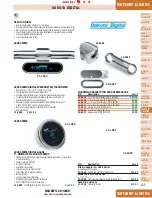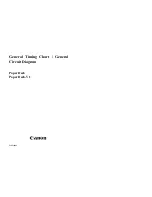
Current as of 2020-03-16
Scheme of available cable connections:
S
HOOTING IN
TTL
M
ODE
•
Set and check camera settings before underwater shooting:
-
Set appropriate camera’s Exposure Meter Type (“Matrix”, “Central-
weighted, “Point”) according your shooting tasks. Right type of
exposure metering is the key setting for accurate TTL work. In case
of wrong setting, the shot may be overlighted, or underlighted.
-
For TTL operation user can set desired sync speed by camera menu,
excluding sync speeds marked as “Auto FP”. According the
construction underwater strobes cannot work in FP synchronization,
that is why “Auto FP” camera command is free for them, and it is
assigned in TTL Converter firmware for switching system to
“Controlled Manual Mode”. Photographer should use it to switch
TTL / M underwater.
-
Set “exposure compensation” and “flash exposure compensation”
to “0ev”, as initial settings.
-
Set appropriate ISO. TTL-Converter can work in ISO range
50….25600. Recommended to use ISO 50….400 for best resolution
and TTL accuracy underwater. For Macro shooting recommended
ISO 50-100.
Be careful choosing extremely high ISO or “Auto-ISO” mode, it may
cause overlighting by underwater strobes.
-
Set camera aperture and shutter speed according real underwater
conditions and shooting task.
-
Set recommended apertures F8-F16 for wide angle photo, and F16-
F22 for Macro photo, as initial settings.
-
Use other settings recommended by your camera User’s Manual.
•
For normal TTL accuracy the minimum distance from strobe to an
underwater subject must be no closer than 0.35 m.
•
Set underwater strobe dial switch to desired TTL mode. Please refer to
strobe User’s Manual to choose appropriate mode. Usually it marked
“S-TTL” (“TTL”, “DS-TTL”) on the strobe’s body.
•
Set (+/-Ev) dial switch on the strobe body to “0ev” position, as initial
setting for Optical TTL usage.
•
For Z-240 electric wire TTL usage set (+/-Ev) dial switch to position “TTL”
(another words “9 o’clock” position)
•
Set TTL-Converter rotary switch according your strobes type:
o
0
– Simple Manual Mode (no TTL, pre-flashes are disabled)
o
1
– Inon Z-240 / Z330
o
2
– Sea&Sea YS-D1
o
3
- Sea&Sea YS-D2
o
4
- Sea&Sea YS-250
o
5
- IkeliteDS-161/160
o
6
- Inon D200/S2000
o
7
- F1-SF150-SF160
o
8
- reserved
o
9
- reserved
•
Slide Hot Shoe connector into the camera Hot Shoe socket.
•
Camera recognizes Nikon compatible TTL device on its HotShoe and
confirms it by appropriate symbol “Flash”on the service screen.
•
Dive and make TTL underwater photo, checking image quality and
histogram via camera LCD.
•
Dependently of concrete underwater subject type, strobes condition,
ambient light underwater and etc., photographer should use +/- TTL
correction (“Flash Exposure Compensation”) to reach balanced TTL
lighting.
•
Photographer can /-TTL correction by 2 ways:
-
Use optical +/- TTL correction (+/-Ev) dial switch on the
underwater strobe body (available for Fiber-optical connection
only).
-
Use camera’s “flash exposure compensation” function for +/- TTL
correction (available for both Fiber-optical TTL and Electric Wire
TTL connections). Available range for Nikon cameras “Flash
exposure compensation”: -3ev…0...+1ev. User can adjust it by
steps 0.3ev or 0.5ev (set by camera menu), v/-Ev value on
the camera screen.
•
TTL-Converter maintains normal accuracy TTL lighting control only for
underwater conditions. Land tests may give little bit different results.
•
Continuous shooting in CL/CH camera modes are available for all
modes of TTL Converter. But, underwater strobe usually recycles a
significant time, so the shots in series will have different lighting. To
reach a constant lighting for few shots in series, user should shoot in
Manual mode at minimum strobe powers.
•
TTL-Converter activates automatically (switch ON) when user pushes
camera’s Shutter Release Button for focusing or shooting. Device goes
to standby mode (switch OFF) also automatically few seconds later,
according the camera command, or after disconnection of camera’s
HotShoe.
•
IMPORTANT!
In some shooting conditions TTL may be not effective or
out of working range. This case please use Manual modes.
S
HOOTING IN
C
ONTROLLED
M
ANUAL
M
ODE
•
Switching to Controlled Manual mode during the dive (underwater) is a
useful feature. It gives possibility to set strobe power manually by the
camera controls. User need not to set power manually on underwater
strobe body, he can keep hands on the housing.
•
Underwater strobes must be set in “S-TTL” (“DS-TTL II”) mode. Strobe’s
dial (+/-Ev) corrector set to “0” position.
•
Switch TTL-Converter to Controlled Manual Mode using the camera
menu:
Bracketing/flash >> Flash sync speed >>
1/200 (Auto FP)
.
Camera setting for any sync speed marked as
“Auto FP”,
points TTL-
Converter to Controlled Manual Mode without pre-flashes. Then
underwater strobe light power can be adjusted by camera controls,
using “flash exposure compensation” function.
•
Available adjustment range for underwater strobe: from Minimum
strobe’s power (displays as “-3ev” on camera screen) to Maximum
strobe’s power (displays as “+1ev” on camera screen). Possible to set
step 0.3ev or 0.5ev, by menu.
•
TTL-Converter does not make pre-flashes in this mode.
•
Pay attention, that “Auto FP” function also makes available to set very
fast shutter speeds on the camera. To avoid mistakes for lighting using
underwater strobes, set shutter speeds not faster than
speed of
synchronization
for your camera. Most Nikon cameras with mechanical
shutter have maximum sync speed 1/200 or 1/250 (without Auto FP).
Some old Nikon cameras have electronic shutter and maximum
synchronization speed up to 1/500 (without Auto FP).
S
HOOTING IN
S
IMPLE
M
ANUAL
M
ODE
Switch system to “M” mode by setting TTL-Converter onboard rotary
switch to “0” position. This operation can be done only before
submerging, when the housing is open. The constant Manual mode will
be set in the system.
TTL protocol is totally disabled. In this mode TTL-Converter makes fixed
pulse at each shutter release of the camera.
Such mode is recommended for creative shooting with long fiber optic
cables (up to 40 m length).
In this Manual mode all Pre-flashes are disabled in system. User should
set “M mode without Pre-flashes” by the dial switch on the strobe body,
and adjust strobe light intensity by the second dial switch on the strobe
body.
S
HOOTING IN
M
ANUAL
M
ODES OF
U
NDERWATER
S
TROBE
•
Photographer can easy set Manual mode using the main dial switch on
the strobe body, independently of TTL-Converter current mode. This is
simple classic way to switch for shooting in Manual mode.
•
Set appropriate type of M mode on the strobe body:
If TTL-Converter is in TTL mode, then set “Manual mode with pre-
flashes” by the switches on the strobe body.





















